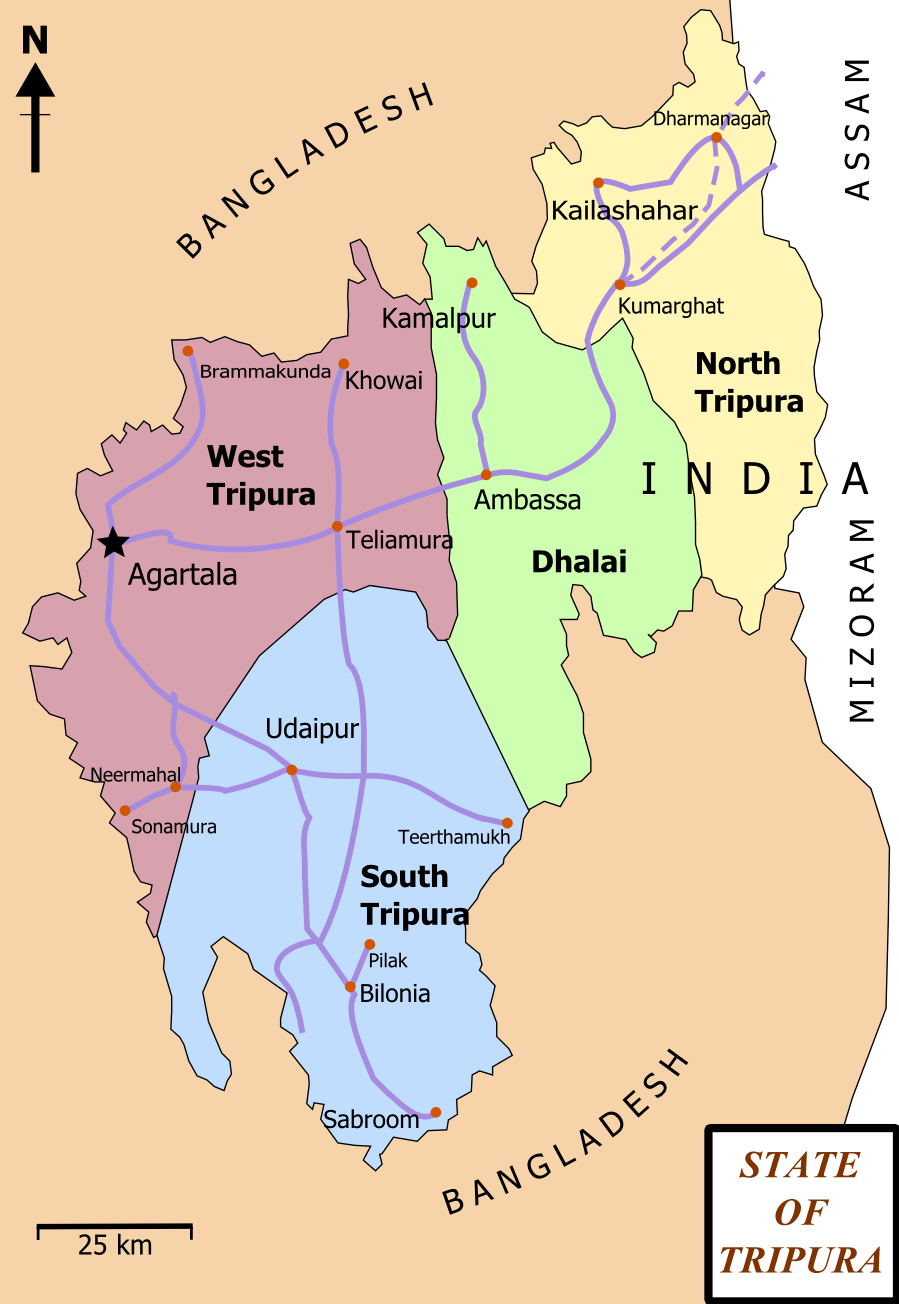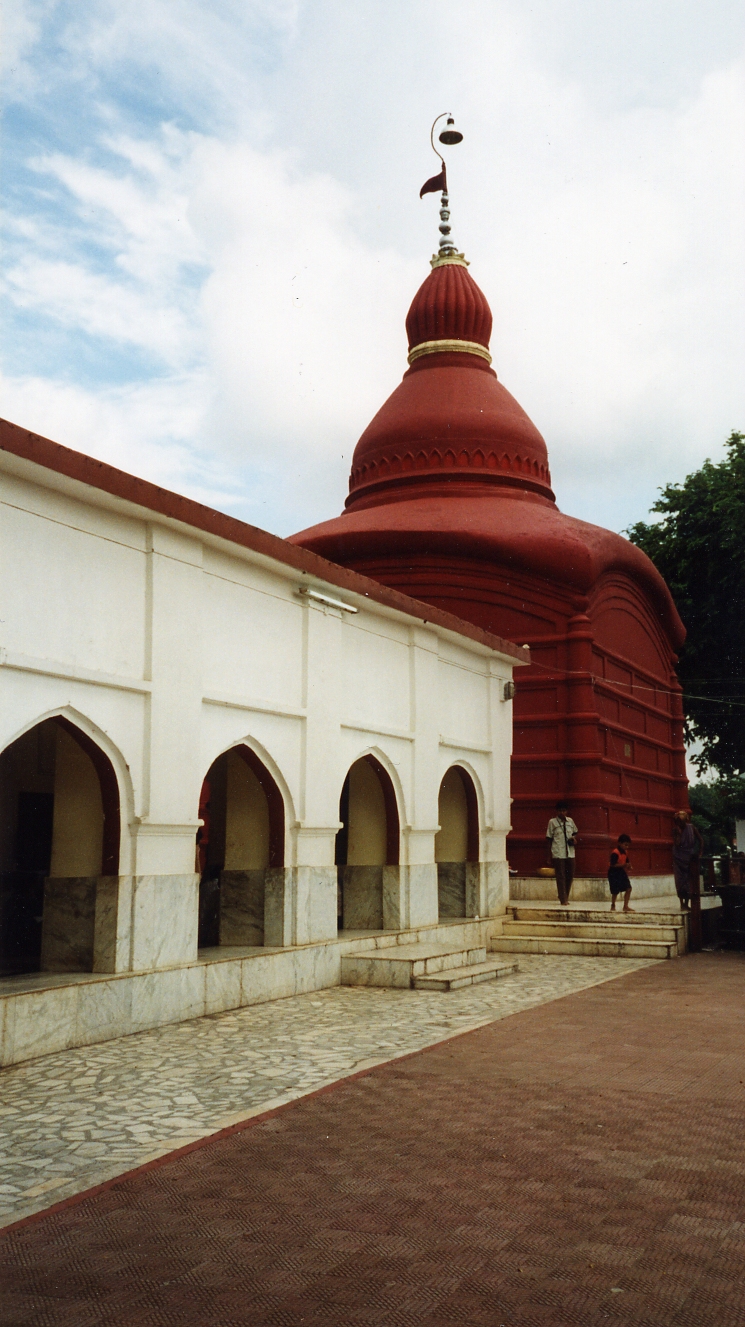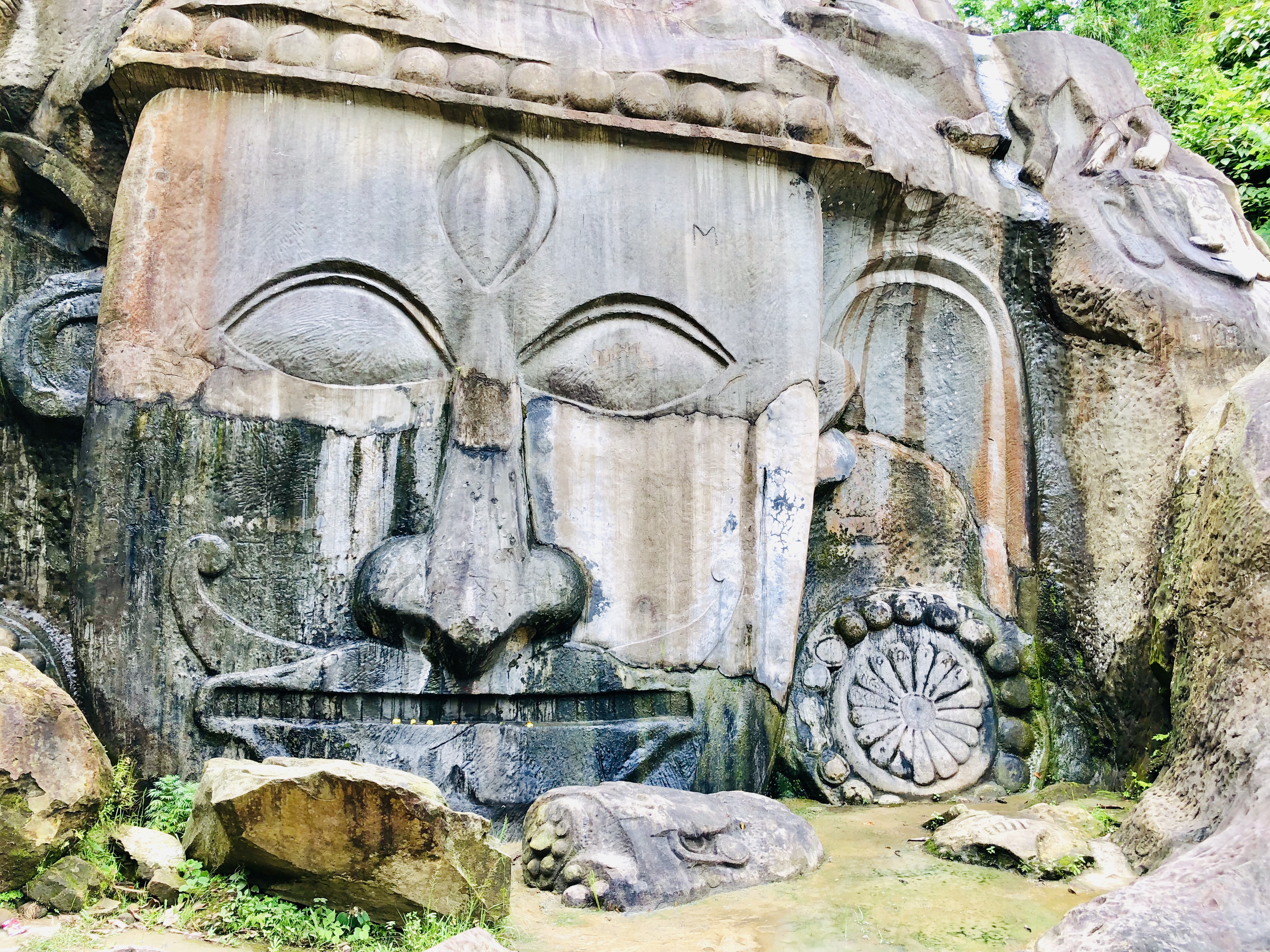|
Sabroom
Sabroom ( bn, সাব্রুম) is a town and a Nagar Panchayat on South Tripura district in the Indian state of Tripura. It is located on the banks of the Feni River, which separates India and Bangladesh. Most of the people speak Noakhailla.It is believed that during the Bangladesh War of Independence in 1971, the Hindu society people migrated from Noakhali and Feni districts of Bangladesh migrated to Sabrum. Geography Sabroom is located at . It has an average elevation of . Demographics India census, Sabroom had a population of 5766. Males constitute 52% of the population and females 48%. Sabroom has an average literacy rate of 82%, higher than the national average of 59.5%: male literacy is 86%, and female literacy is 78%. In Sabroom, 11% of the population is under 6 years of age. Politics Sabroom assembly constituency is part of Tripura East (Lok Sabha constituency). See also * List of cities and towns in Tripura Tripura is a state in Northeast India. The thir ... [...More Info...] [...Related Items...] OR: [Wikipedia] [Google] [Baidu] |
Feni River
Feni River ( bn, ফেনী নদী ; ISO: ''Phēnī Nadī'' ) is a river in southeastern Bangladesh and Tripura state of India. It is a trans-boundary river with an ongoing dispute about water rights. The Feni River originates in South Tripura district and flows through Sabroom town and then enters Bangladesh. Muhuri River, also called Little Feni, from Noakhali District joins it near its mouth. The river is navigable by small boats as far as Ramgarh, about upstream. The question of sharing of the waters of the river between India and Pakistan was first discussed in 1958. Through at least 2006 the countries continued to consider possible compromises. Course Feni River originates in South Tripura district and flows through Sabroom town and then enters Bangladesh. Muhuri River, also called Little Feni, from Noakhali District joins it near its mouth. The river is navigable throughout the year by small boats up to Ramgarh, some upstream. Dispute The question of sharing of ... [...More Info...] [...Related Items...] OR: [Wikipedia] [Google] [Baidu] |
Tripura East (Lok Sabha Constituency)
Tripura East is one of the two Lok Sabha constituencies in Tripura state in northeastern India. The seat is reserved for scheduled tribes. In the first elections in 1952 the seat was represented by Dasarath Deb, the leader of the Ganamukti Parishad uprising. Assembly segments Tripura East Lok Sabha constituency is composed of the following assembly segments: Members of Parliament Election results General election 1952 General election 1957 For this election Tripura became one Lok Sabha constituency with two representatives in parliament. The two representatives were Dasarath Deb of the Communist Party of India and Bangshi Deb Barma of the Indian National Congress. General election 1962 General election 1967 General election 1971 General election 1977 General election 1980 General election 1984 General election 1989 General election 1991 General election 2004 Gener ... [...More Info...] [...Related Items...] OR: [Wikipedia] [Google] [Baidu] |
South Tripura District
South Tripura ( bn, দক্ষিণ ত্রিপুরা জেলা) is an administrative district in the state of Tripura in northeastern India. History The district came into existence on 1 September 1970, when the entire state was divided into three districts. Geography The district occupies an area of . The district headquarters are located at Belonia. Divisions District has three sub divisions ( Belonia, Sabroom and Santirbazar). The district resides in two Lok Sabha constituencies: Tripura West (shared with West Tripura district) and Tripura East (shared with Dhalai and North Tripura districts. It is also split between seven Legislative assembly constituencies : Belonia, Hrishyamukh, Jolaibari, Manu, Rajnagar, Sabroom and Santirbazar. Demographics According to the 2011 census South Tripura district has a population of 876,001, roughly equal to the nation of Fiji or the US state of Delaware. This gives it a ranking of 471st in India (out of a total of ... [...More Info...] [...Related Items...] OR: [Wikipedia] [Google] [Baidu] |
Tripura
Tripura (, Bengali: ) is a state in Northeast India. The third-smallest state in the country, it covers ; and the seventh-least populous state with a population of 36.71 lakh ( 3.67 million). It is bordered by Assam and Mizoram to the east and by Bangladesh to the north, south and west. Tripura is divided into 8 districts and 23 sub-divisions, where Agartala is the capital and the largest city in the state. Tripura has 19 different tribal communities with a majority of the Bengali population. Bengali, English and Kokborok are the state's official languages. The area of modern Tripura — ruled for several centuries by the Manikya Dynasty — was part of the Tripuri Kingdom (also known as Hill Tippera). It became a princely state under the British Raj during its tenure, and acceded to independent India in 1947. It merged with India in 1949 and was designated as a 'Part C State' ( union territory). It became a full-fledged state of India in 1972. Tripura lies in a geographic ... [...More Info...] [...Related Items...] OR: [Wikipedia] [Google] [Baidu] |
List Of Cities And Towns In Tripura
Tripura is a state in Northeast India. The third-smallest state in the country, it covers and is bordered by Bangladesh (East Bengal) to the north, south, and west, and the Indian states of Assam and Mizoram to the east. In 2011 the state had 3,671,032 residents, constituting 0.3% of the country's population. Native Tripuri people form about 30 per cent of Tripura's population. The Bengali people form the ethno-linguistic majority in Tripura. The entire work of this article is based on Census of India, conducted by "The Office of the Registrar General and Census Commissioner, India" under Ministry of Home Affairs, Government of India. According to the data from the Census of 2011, there are 8 districts, 23 sub-divisions and 20 municipal towns in the state of Tripura. There is only one city in this state with a Municipal Corporation - Agartala and thirteen towns with Municipal Council as per latest data. References {{reflist External links Census of India website list of Tripu ... [...More Info...] [...Related Items...] OR: [Wikipedia] [Google] [Baidu] |
Tripura Map
Tripura (, Bengali: ) is a state in Northeast India. The third-smallest state in the country, it covers ; and the seventh-least populous state with a population of 36.71 lakh ( 3.67 million). It is bordered by Assam and Mizoram to the east and by Bangladesh to the north, south and west. Tripura is divided into 8 districts and 23 sub-divisions, where Agartala is the capital and the largest city in the state. Tripura has 19 different tribal communities with a majority of the Bengali population. Bengali, English and Kokborok are the state's official languages. The area of modern Tripura — ruled for several centuries by the Manikya Dynasty — was part of the Tripuri Kingdom (also known as Hill Tippera). It became a princely state under the British Raj during its tenure, and acceded to independent India in 1947. It merged with India in 1949 and was designated as a 'Part C State' ( union territory). It became a full-fledged state of India in 1972. Tripura lies in a geographica ... [...More Info...] [...Related Items...] OR: [Wikipedia] [Google] [Baidu] |
Kokborok Language
Kokborok (also known as Tripuri or Tiprakok) is the main native language of the Tripuri people of the Indian state of Tripura and neighbouring areas of Bangladesh. Its name comes from ''kok'' meaning "verbal" and ''borok'' meaning "people" or "human" and is one of the ancient languages of Northeast India. History Kokborok was formerly known as Tripuri & Tipra kok, with its name being changed in the 20th century. The names also refer to the inhabitants of the former Twipra kingdom, as well as the ethnicity of its speakers. Kókborok has been attested since at least the 1st century AD, when the historical record of Tripuri kings began to be written down. The script of Kókborok was called "Koloma". The Chronicle of the Tripuri kings were written in a book called the ''Rajratnakar''. This book was originally written down in Kókborok using the Koloma script by Durlobendra Chontai. Later, two Brahmins, Sukreswar and Vaneswar translated it into Sanskrit and then again translated ... [...More Info...] [...Related Items...] OR: [Wikipedia] [Google] [Baidu] |
WikiProject Indian Cities
A WikiProject, or Wikiproject, is a Wikimedia movement affinity group for contributors with shared goals. WikiProjects are prevalent within the largest wiki, Wikipedia, and exist to varying degrees within sister projects such as Wiktionary, Wikiquote, Wikidata, and Wikisource. They also exist in different languages, and translation of articles is a form of their collaboration. During the COVID-19 pandemic, CBS News noted the role of Wikipedia's WikiProject Medicine in maintaining the accuracy of articles related to the disease. Another WikiProject that has drawn attention is WikiProject Women Scientists, which was profiled by '' Smithsonian'' for its efforts to improve coverage of women scientists which the profile noted had "helped increase the number of female scientists on Wikipedia from around 1,600 to over 5,000". On Wikipedia Some Wikipedia WikiProjects are substantial enough to engage in cooperative activities with outside organizations relevant to the field at issue. For ex ... [...More Info...] [...Related Items...] OR: [Wikipedia] [Google] [Baidu] |
Census
A census is the procedure of systematically acquiring, recording and calculating information about the members of a given population. This term is used mostly in connection with national population and housing censuses; other common censuses include censuses of agriculture, traditional culture, business, supplies, and traffic censuses. The United Nations (UN) defines the essential features of population and housing censuses as "individual enumeration, universality within a defined territory, simultaneity and defined periodicity", and recommends that population censuses be taken at least every ten years. UN recommendations also cover census topics to be collected, official definitions, classifications and other useful information to co-ordinate international practices. The UN's Food and Agriculture Organization (FAO), in turn, defines the census of agriculture as "a statistical operation for collecting, processing and disseminating data on the structure of agriculture, covering th ... [...More Info...] [...Related Items...] OR: [Wikipedia] [Google] [Baidu] |
Feni District
Feni is a district located in southeastern Bangladesh. It was a part of the Greater Noakhali, Comilla, Chittagong and Tripura. , the district's estimated population stood at 1,437,371, making it the ninth-most populous district in Chittagong Division. The administrative hub of the district is in Feni City, which also serves as the headquarters of Feni Sadar Upazila in the central section of the district. The original name of the district was Shamshernagar, which served as a mahakuma under the district of Noakhali (greater part), Comilla (few part) and Chittagong District (at rest) until 6 December 1984. It is the 64th Number Districts of Bangladesh. The district consists of six sub-districts: Sonagazi, Fulgazi, Parshuram, Daganbhuiyan, Chhagalnaiya and Feni Sadar. History In the opinion of most historians, the area of this district is more ancient than the other areas of the greater Noakhali region. Many archaeological antiquities were found in this district which prov ... [...More Info...] [...Related Items...] OR: [Wikipedia] [Google] [Baidu] |
Noakhali
Noakhali ( bn, নোয়াখালী, , New canal), historically known as Bhulua ( bn, ভুলুয়া), is a district in southeastern Bangladesh, located in the Chittagong Division. It was established as district in 1821, and officially named Noakhali in 1868. Its headquarters lie in the town of Maijdee, making Noakhali the only district of Bangladesh that isn't named after its town name. Etymology and names The name of Noakhali District comes from the town of Noakhali (নোয়াখালী), which was the former headquarters of the old district. It is a compound of two words; ''Noa'' (meaning new in Noakhailla) and ''Khali'' (a diminutive of ''khal'' meaning canal). The history behind its naming is traced back to a canal that was dug in the 1660s in response to devastating floods which had affected the area's agricultural activities. The canal ran from the Dakatia through Ramganj, Sonaimuri and Chowmuhani, to divert water flow to the junction of the Meghna ... [...More Info...] [...Related Items...] OR: [Wikipedia] [Google] [Baidu] |




